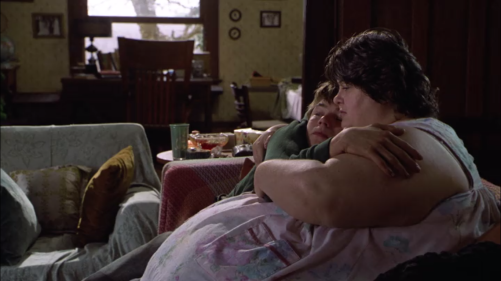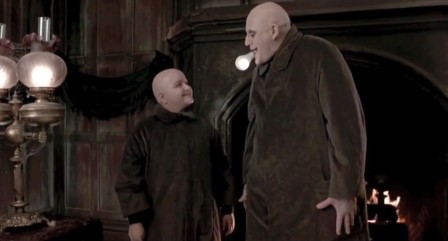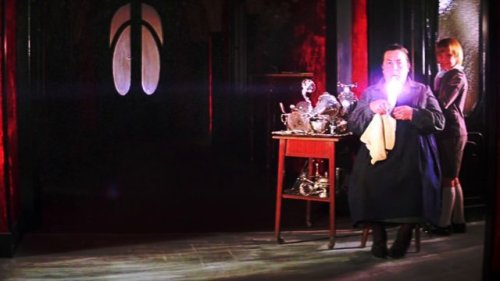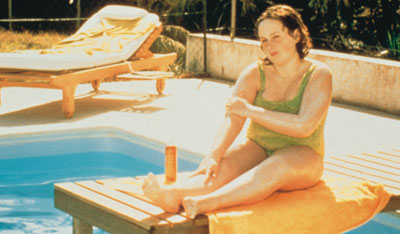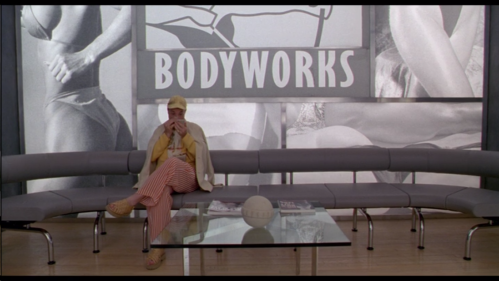My intention with this series of posts about romantic storylines featuring fat men and thin women was to choose films using a specific parameter: fat men and thin women who start a relationship during the course of the film and are still together when it ends. This time around, that ended up being more of a hindrance than help. I wanted to focus on adolescent characters, so I watched three films with fat male protagonists and plot summaries that suggested romance– Angus, The Motel* and Terri. None of the three ended with the hero happily coupled with the object of his affections; The Motel and Terri end in explicit rejection. This surprised me. Certainly not all coming of age films focus on romance, or even use beginning a relationship to signify maturation. Neither film I watched last summer with fat boy protagonists, Chubby and Heavyweights, had romantic storylines for their protagonists, though I suspect that’s more to do with the protagonists being closer to childhood than young adulthood. I wanted stories of fat characters learning to believe in themselves to include at least some subversion of the assumption that they wouldn’t be able to find willing romantic partners. But as I have a prolific once-per-month posting average to maintain, plus these films have some interesting similarities and center fat characters more than most, I figure they’re worth talking about.
As is required by the genre, all three young protagonists need to learn important life lessons in order to confront or transcend the difficult situations they find themselves in at the beginnings of their respective stories. All three are outsiders. Terri (Jacob Wysocki) and Angus(Charlie Talbert) are bullied and unpopular explicitly because they are fat. This isn’t as much the case for The Motel’s Ernest (Jeffrey Chyau), although he is not shown at his school nearly as much as the other two boys. He is nonetheless othered due to his ethnicity and class status, as part of a Chinese-American family who eke out a living running a cheap motel. It’s worth noting that all three have nontraditional family structures. In addition to the dynamic of the family business and having a home culture that’s markedly different from that of the society around him, Ernest’s father abandoned their family. Angus’ father died soon after Angus was born; his family consists of his tough-as-nails trucker mom (Kathy Bates) and his tough-as-nails grandfather (George C. Scott). (Worth noting: in the short story that Angus is based on, “A Brief Moment in the Life of Angus Bethune,” his mother and father are both gay and remarried to stepparents of the same gender. Moviegoing America apparently wasn’t ready for that particular configuration of loving but alternatively-structured family in the mid 90s.) Both of Terri’s parents are MIA; his only family member is an uncle (Creed Bratton) who has an unnamed illness. As part of their atypical families, the boys all must take on atypical roles for teenage boys. Terri and Angus act as caretakers for their elder male relatives, while Ernest works housekeeping duty at the motel. Not only are these roles feminized and serve to detract from any hope they have of conforming to romantic male lead standards as much as being fat does, but also detract from the amount of time they have to spend with their peers (and therefore mean fewer opportunities to meet and interact with girls).

Melissa (Ariana Richards) and Angus (Charlie Talbert), the Winter Ball Court/Unwilling Spectacle
Angus also features an interesting story beat around othering and feminization in terms of clothing. Fat bodies in movies (and also in, you know, society) vacillate between invisible/excluded and hypervisible/spectacle. When Angus is elected king of the Winter Ball as a prank, he is suddenly recategorized, going from having his achievements on the football field ignored to facing having to dance with his long-time crush in front of the whole school. The intent/expectation that he will suffer humiliation is compounded when he has to rent a tuxedo, but despite protests that he wants a “socially acceptable” black tuxedo, his only option is purple. But what seems like a cruel parody of the role he is supposed to embody becomes a symbol of his defiance, a dare for people to accept him instead of an invitation to mock him. Terri and Ernest both have specific clothing, but it reinforces their invisibility. Terri wears pajamas 24/7 (which I took as a symptom of depression), but nobody notices or asks except when his assistant principal makes him a special project. Ernest tends to wear t-shirts that are garish, especially when compared to his mild personality; without saying anything, it’s obvious that they were purchased from a thrift store.
The combination of social isolation and difficult personal life also make the protagonists’ relationship with an older male figure important to their maturation. Terri has a tenuous relationship with Mr. Fitzgerald (John C. Reilly), the assistant principal who can act thoughtlessly at times, but also models the self-confidence and tenacity that Terri lacks, opening up to the depressed student before he himself is willing to open up. Angus has Grandpa, whose motto is “screw ‘em.” He is marrying a woman thirty years younger than him; his stubborn refusal to let others’ judgments sway his decisions and his ability to woo a beautiful woman despite being old and fat both inspire Angus and foreshadow his success with the girl he has a crush on. Ernest’s grandfather (Stephen Chen) takes a very hands-off approach to parenting (but does pick on his weight). Luckily for Ernest, he is the main character in an indie dramedy and is therefore destined to cross paths with an eccentric loose cannon who brings some fun and freedom into his seemingly hopeless life, Sam (Sung Kang). Sam tries to be a surrogate father figure, teaching him how to drive and trying to convince him to stand up for himself. However, Sam is also more toxic than Grandpa or Mr. Fitzgerald, as a self-destructive divorcee who manipulates Ernest into letting him stay at the motel without paying.
In addition to older male characters who teach the protagonists how to navigate being an outsider, the love interest characters are also outsiders in their own rights. Despite being a popular cheerleader, Melissa (Ariana Richards) is as much a victim of bullying as Angus, as her boyfriend Rick (James Van Der Beek) uses her as a pawn to try and humiliate our hero. During the climactic scene at the school Winter Ball dance, she admits to Angus that not only is she as nervous as he is about being publicly humiliated, but she is also bulimic, something she had never told anyone else. “Do you ever get tired of who you are?” she asks him. “Do you know who you’re talking to?” he responds. Terri has a crush on Heather (Olivia Crocicchia), who becomes a social outcast when a classmate fingers her in class. This is partly Terri’s fault: his outsider status allows him moments of quiet observation where he sees the otherwise surreptitious sex act, his other classmates then see what he’s looking at and make a scene. He does, however, attempt to make things right by defending her to Mr. Fitzgerald, who wants to expel her, and detracting unwanted attention from her in subsequent classes. His support builds their friendship and gives him a shot with her when she suggests they hang out together after school. Despite being conventionally attractive, in contrast to the protagonists, Heather and Melissa both have bodies that require regulation, Heather through slut-shaming and Melissa through an eating disorder. In this way, they find empathy and companionship through the boys who are social pariahs for their own unruly bodies. In The Motel, however, similarity is a problem. Christine (Samantha Futerman), like Ernest, is part of a Chinese immigrant family and has an atypical childhood for an American kid, working at her family’s business. Unlike the other two films, their similar outsider status may be what prevents any potential romance. When giving Ernest advice on romance, Sam tells him that Christine won’t want him because he reminds her of her upbringing, and she wants a boyfriend who will offer her escape.

Ernest (Jeffrey Chyau) and Christine (Samatha Futerman), finding relief from their jobs together
Perhaps because of empathy gained from being an outsider, or because of the feminized roles they play in their family lives, the protagonists treat the girls with more respect than do their male peers. (Given that there is no culmination in romance, especially for Ernest and Terri, The Motel and Terri risk a “nice guy” dynamic.) While Terri protects Heather and respects her boundaries, his friend Chad plans to get her drunk and have sex with her because he thinks she’s an easy target due to her reputation. As mentioned above, Rick uses Melissa in a plan to humiliate Angus without her consent, then gets mad at her when she teaches Angus how to dance instead of allowing him to fail. Ernest stands by while three classmates of Christine’s trespass on her family’s property to skate and try to get her to give them free food. She hesitantly agrees, uncomfortable with the idea but longing for their approval. Even outside a romantic context, there is a tacit trust and intimacy between each pair that the female characters lack in other interactions with male peers.
Angus is the only film of the three that ends with ambiguous potential for romance. Notably, Angus is also the most idealized protagonist. He makes a lot of self-deprecating comments about being fat, but he is on the football team, being considered for a prestigious magnet school, and is able to stand up for himself. He is able to physically overpower Rick, but can’t because he faces suspension. His character growth is about replacing his fists with words, naturally culminating in a speech that is the best moment in the film. The last scene of the film is Melissa giving him a kiss on the cheek after he walks her home. What’s to come of this we don’t know, but in all fairness, she did just get royally screwed over by her jerk boyfriend. Some time to herself would be healthy. Both Heather and Christine also deal with external circumstances that affect any desire for romance with Terri or Ernest, fatness not ever being an explicit factor. Heather’s classmates have ostracized her due to being sexually active. Terri has a chance to have sex with her (he doesn’t) because she is drunk. She leaves a note for Terri asking that he not talk about the incident at school and emphasizing that she is his friend. And in The Motel, as previously noted, Christine’s lack of attraction for Ernest may be due to associating romance with escape from her family life.

Terri (Jacob Wysocki), concerned for Heather’s (Olivia Crocicchia) wellbeing
Although none of the films end happily with romance, they do end on hopeful notes as we see signs of maturation in the protagonists. Ultimately, the resolution has more to do with their relationships with their older male role models than their female love interests. Angus, as previously noted, learns to solve his problems with dramatic speeches instead of violence and discovers that idealized Melissa is a vulnerable human being, because he takes Grandpa’s advice to “screw ‘em” (repeated to him by Melissa) and does what he wants despite potentially being judged by others. “I’d had my moment,” he tells the audience in the ending narration, “and then I heard my grandfather’s voice say to me, ‘Go have another.’” After being rejected by Heather, Terri spends a day with Mr. Fitzgerald, not only for his own benefit but also to give the older man company, as he is separating from his wife and sleeping in his car on school grounds. “She’s embarrassed,” he tells Mr. Fitzgerald. “I’m not going to say anything if that’s what she’s worried about… I don’t think I’m read for all that stuff yet, anyway.” “Who is, you know?” Mr. Fitzgerald responds. The last shot is of Terri walking through the woods by himself, looking content. The Motel’s climax sees Ernest confronting Sam, refusing to be manipulated and telling Sam that he has to leave the motel if he isn’t going to pay for his room. Instead of having to passively accept that his father left him, he is able to actively reject a dad-analogue figure for not treating him with respect. The boys all learn to value themselves despite the fatphobic (and in Ernest’s case, racist) rhetoric thrown at them; even if the expectation that a fat boy would fail at a romantic endeavor isn’t necessarily subverted, the expectation that a fat boy would fail to love himself is unquestionably skewered by all three films.
*If discussion about The Motel seems less detailed than the other two films, it’s because it was the first of the three I watched, and I lost my notes. It’s definitely worth watching, though.
